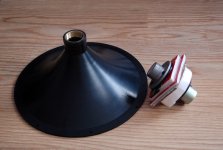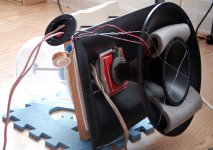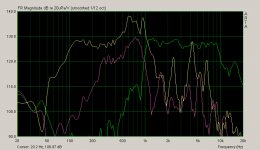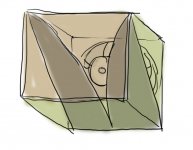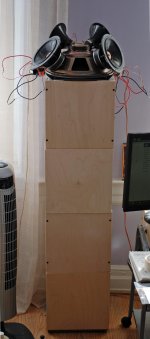I left all my good speakers behind when moved into a new apartment. Finally I decided to construct new speakers from parts I already have, to replace boring 3in full rangers. This is what I have so far. There are some problems around 600hz, crossovers are still in development  Nevertheless, sound is far superior to small speaker I used before.
Nevertheless, sound is far superior to small speaker I used before.
http://imageshack.us/photo/my-images/707/1mqr.jpg/
http://imageshack.us/photo/my-images/35/4dl0.jpg/
http://imageshack.us/photo/my-images/46/et61.jpg/
http://imageshack.us/photo/my-images/707/1mqr.jpg/
http://imageshack.us/photo/my-images/35/4dl0.jpg/
http://imageshack.us/photo/my-images/46/et61.jpg/
Last edited:
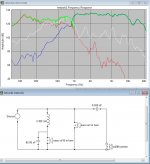
Mid driver is crossover-less, adding more components results in impedance drop down to 2 ohm. It may be possible to manage in mid-driver with a lot of components, but I prefer minimalistic designs. I'm modeling series crossover for these speakers. I can't quite figure out logic in series crossovers, so mostly trial and error method is used.
Another woofer is added to the nest(12in kenwood) Making it a four way speaker.
U-frame does produce unwanted resonances, see 170-300hz region.
I'd make it sealed, but woofer has very high Q, which would require box of a refrigerator size.
Next step is to find foam blocks to staff u-frame.
I am convert to coaxial designs. The unity of the sound is remarkable, especially with near-field listening.
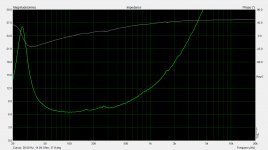
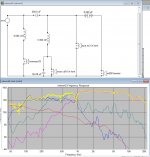
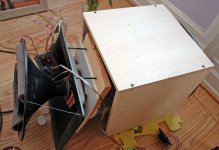
U-frame does produce unwanted resonances, see 170-300hz region.
I'd make it sealed, but woofer has very high Q, which would require box of a refrigerator size.
Next step is to find foam blocks to staff u-frame.
I am convert to coaxial designs. The unity of the sound is remarkable, especially with near-field listening.



I made Karlson wings. They do something but nothing that would improve performance. I hoped to smooth out peaks around 200hz.
I went back to previous design. Some foam blocks in cabinet corners is best solution. Dense foam stuffing creates even more prominent impedance peak at 200Hz.
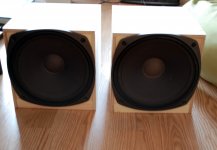
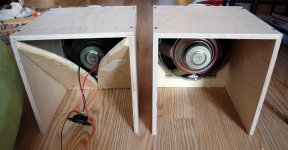
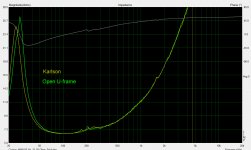
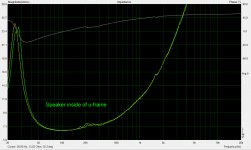
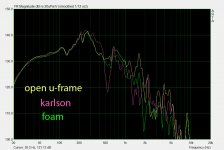
Last thing to try is to raise u-frames above floor, making them n-frames )
I went back to previous design. Some foam blocks in cabinet corners is best solution. Dense foam stuffing creates even more prominent impedance peak at 200Hz.





Last thing to try is to raise u-frames above floor, making them n-frames )
From the impedance plot, I see Karlson breaks the original peak @200Hz into several lower peaks.
So it does have som effect. Maybe the increased load OTOH enhances the peak response.
Did you try flipping it upside down and let the large side of K-slot pointing down to the floor?
So it does have som effect. Maybe the increased load OTOH enhances the peak response.
Did you try flipping it upside down and let the large side of K-slot pointing down to the floor?
Yes I know it's OB.
And that's exactly what I'm thinking -- to make more difference to the front/rear path lengths in various positions.
I think the 200Hz peak is probably the 1/4 wavelength resonance of the U-baffle (is the depth 40-ish cm?). Isn't it the major 'enemy' you want to fight?
And that's exactly what I'm thinking -- to make more difference to the front/rear path lengths in various positions.
I think the 200Hz peak is probably the 1/4 wavelength resonance of the U-baffle (is the depth 40-ish cm?). Isn't it the major 'enemy' you want to fight?
it's about 31cm. They are not efficient enough to keep up with the rest of the drivers as it is. On open baffle, they will be even less efficient, and I like to place things on top of these speakers 
I tried to raise u-frame from the floor, results are even worse.
I should convert them to sealed.
I tried to raise u-frame from the floor, results are even worse.
I should convert them to sealed.
I put kenwood woofers aside, they need at least 8cubic feet sealed box.
For seas 0.64 qft is a little small also, they would perform best in 1.5 qft sealed box or 3qft ported.
Initially I made a two way coaxial, they sounded nice. I discovered that I prefer sound coming from one coaxial speaker. Plug second one for a stereo and coaxial "magic" is lost.
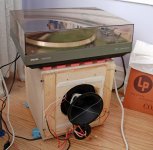
Here is my attempt to mix stereo to mono in coaxial arrangement.
I still don't know what to think of its sound, need to spend more time with it.
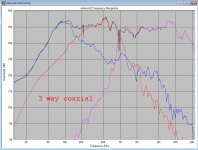
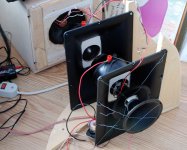
Another idea, is to build a unity horn with both stereo channels firing into the same horn.
Stereo imaging is an unnatural effect, it is impressive for a short period of listening or for effects in movies. I've never experienced any imaging effects during live performances. With stereo, I feel, we are listening through a microphone, we just learned to accept it as truthful sound. Just like with photography, we learned to accept horrendous lens distortion as truthful representation.
For seas 0.64 qft is a little small also, they would perform best in 1.5 qft sealed box or 3qft ported.
Initially I made a two way coaxial, they sounded nice. I discovered that I prefer sound coming from one coaxial speaker. Plug second one for a stereo and coaxial "magic" is lost.

Here is my attempt to mix stereo to mono in coaxial arrangement.
I still don't know what to think of its sound, need to spend more time with it.


Another idea, is to build a unity horn with both stereo channels firing into the same horn.
Stereo imaging is an unnatural effect, it is impressive for a short period of listening or for effects in movies. I've never experienced any imaging effects during live performances. With stereo, I feel, we are listening through a microphone, we just learned to accept it as truthful sound. Just like with photography, we learned to accept horrendous lens distortion as truthful representation.
Last edited:
It is a temporary placement for a turntable. Even though it never skipped a track.
I meant mainstream cameras. Photos from view cameras are definitely closer to what we see.
No need for ear level placement, we eliminated all special effects,speakers just need to be placed near the center of the wall.
Orchestra pit for instance is not on ear level with listeners.
I'm trying to find out if there is any benefit with acoustical vs electrical stereo channels mixing.
I meant mainstream cameras. Photos from view cameras are definitely closer to what we see.
No need for ear level placement, we eliminated all special effects,speakers just need to be placed near the center of the wall.
Orchestra pit for instance is not on ear level with listeners.
I'm trying to find out if there is any benefit with acoustical vs electrical stereo channels mixing.
First thing wrong that I see: the cone of the horn just in front of the woofer's cone.
If noone's expecting any midrange, it might be ok.
As I don't see any wall in front of the orchestra pit...
And since you nominated it, you should make a distinction between original/live event and the reproduced one. You need musicians, director and a hall for the first.
For the reproduced sound you need some media to hold the recording, some stages of amplification and transducers, and a room.
The media between the two is the microphone, well, at least two!
So we have two tracks, where time is the factor of coherence. But time and space are well correlated, too. As sound travels, it decays in amplitude.
These two tracks are in synchro. Mixing them you defeat the work that has been put on making the media. POF! Gone! Where are my synchronized two channels that display what has been catched and recorded ?
And... the tweeter has to be at ear level for some reason
If noone's expecting any midrange, it might be ok.
As I don't see any wall in front of the orchestra pit...
And since you nominated it, you should make a distinction between original/live event and the reproduced one. You need musicians, director and a hall for the first.
For the reproduced sound you need some media to hold the recording, some stages of amplification and transducers, and a room.
The media between the two is the microphone, well, at least two!
So we have two tracks, where time is the factor of coherence. But time and space are well correlated, too. As sound travels, it decays in amplitude.
These two tracks are in synchro. Mixing them you defeat the work that has been put on making the media. POF! Gone! Where are my synchronized two channels that display what has been catched and recorded ?
And... the tweeter has to be at ear level for some reason

Exactly. That's why I'm moving speakers to another room. I'll post an update when set up is finished.As I don't see any wall in front of the orchestra pit...
I forgot that I've started a thread with similar topic.
http://www.diyaudio.com/forums/everything-else/195093-listening-speakers-far-distance.html
After all this time, I arrived to the same conclusion, most enjoyable sound is the one that travels some distance, in case of a small apartment, it has to come from another room.
Hmmm, I didn't mean that. I was talking about the very nested horn that covers most of the emission of the woofer. But if you want to make a comparison between sound sources, being large or (quasi) point source, it's ok!
The woofer looks very little compared to the horn: it's not a 15" !
Talking about the in-house listening, yes, a 20 Hz wave needs 17 m to make
a complete cycle. Same in hall where there's a organ playing: just a "little" difference in amplitude and "promptness", velocity !
So ?
Talking about dispersion and its contrary, directivity, and power applied in the very room, and bounces on the walls....
The woofer looks very little compared to the horn: it's not a 15" !
Talking about the in-house listening, yes, a 20 Hz wave needs 17 m to make
a complete cycle. Same in hall where there's a organ playing: just a "little" difference in amplitude and "promptness", velocity !
So ?
Talking about dispersion and its contrary, directivity, and power applied in the very room, and bounces on the walls....
- Status
- This old topic is closed. If you want to reopen this topic, contact a moderator using the "Report Post" button.
- Home
- Loudspeakers
- Multi-Way
- nested horns
